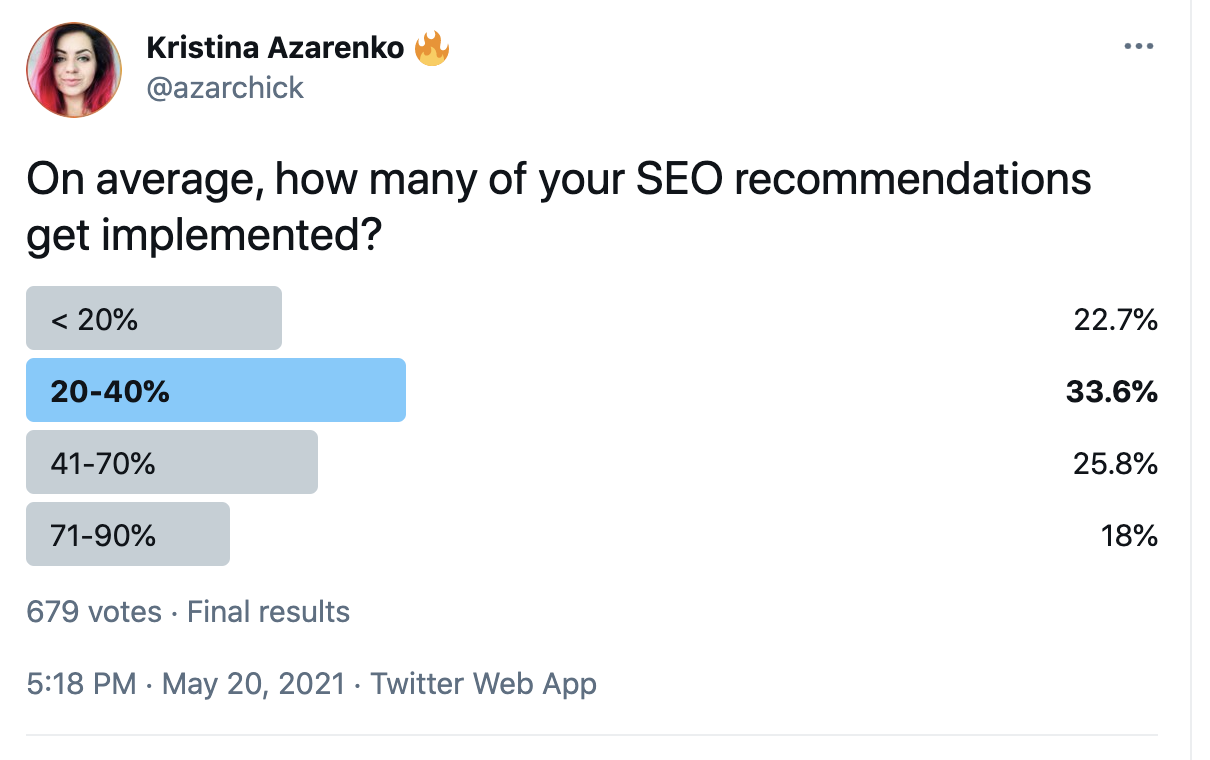When you work in SEO long enough, you start noticing that the success of your SEO strategy doesn’t only depend on how good this strategy is. It’s only part of the whole picture.
What matters most is proper implementation.
In fact, according to the poll I recently did, most SEO professionals say that less than 40% of their SEO recommendations are implemented:
 Things get even harder when you’re not the one who controls and does the implementation.
Things get even harder when you’re not the one who controls and does the implementation.
Many tasks, especially technical ones are dependable on developers. And that’s where many great recommendations meet harsh reality and stay buried somewhere on a Google Drive or JIRA.
SEO Is Not Only About Recommendations – It’s About People, Too
One reason why many SEO recommendations are not implemented (or not implemented properly) is because there’s a misunderstanding between people.
If you phrase your recommendations using the language developers don’t resonate with, it will be hard to convince them and also give detailed and straightforward requirements.
That’s where SEO user stories come in.
Communicate SEO Recommendations with User Stories
The first time I heard about user stories was more than 2 years ago. I was working as part of an agency team helping a big client with a complex migration project.
There were many teams involved – including multiple developers that we didn’t have direct access to. But everything worked out well.
That whole experience showed me the power of user stories so I’ve been using them with my clients since then. It has significantly improved the communication with developers, too.
Why is a user story a really good tool for communicating technical SEO recommendations or requirements?
Because user stories:
- Are concise.
- Are actionable.
- Are clear and straightforward.
- Are easy to follow.
- Account for user testing.
What Is an SEO User Story Exactly?
In the development world, a user story is an informal description of some feature in the software. It’s part of an agile process.
An SEO user story is a small recommendation that has a clear action and outcome and helps to break down big strategies into smaller steps.
A user story consists of three parts:
- A user type (“As a {user}”)
- An action (“I want, {action}”)
- An outcome (“so that {an outcome}”)
When put together, a user story template looks like this:
As a {user type}, I want {an action}, so that {an outcome}.
Here’s an example of an SEO user story:
As an SEO manager, I want the robots.txt file to be added to the website so that Google and other search engines can crawl the pages that need to be ranked.
Acceptance Criteria? Yes, Please
What’s next after you have a user story?
You will also need a way to explain when the user story can be marked as “Done” – the acceptance criteria.
Acceptance criteria show how things should look when the user story is implemented correctly.
Let’s get back to the example SEO user story above:
As an SEO manager, I want the robots.txt file to be added to the website so that Google and other search engines can crawl the pages that need to be ranked.
It says that you need the robots.txt file. But you also need a way to explain where it should be located and what directives it should have. It’s what acceptance criteria do.
Here is an example of acceptance criteria for this users story:
- The robots.txt file exists at {URL HERE}.
- The robots.txt file URL returns a 200 HTTP status code.
- The robots.txt file allows the crawling of all critical website pages and matches the directives:
User-agent: * Disallow:
It helps to communicate to a developer what you want to achieve in your SEO recommendation. And it’s up to a developer how they’re going to implement it since it’s their area of expertise.
How to Write SEO User Stories & Acceptance Criteria
There are a few steps that you’ll need to do to write a good SEO user story and acceptance criteria for it.
Step 1: Identify a Small Part of the Recommendations You’re Going to Write a User Story For.
You don’t want to use a huge recommendation like “I want to fix all canonicalization issues on the website.”
Instead, you break down the recommendation into smaller pieces. For example:
- All URL variations should be redirected to the canonical URLs.
- All canonical URLs should have self-referencing canonicals.
- All internal links should point to canonical URLs.
Step 2: Then You Take One of the Pieces and Answer the Following Question:
“Why is this important?”
You need to be concise here, answer in one phrase.
Lets’s use the third piece as an example:
“All internal links should point to canonical URLs.”
Why is this important?
So that we’re sending the right signals to Google.
Step 3: Write a User Story Based on Step 1 and Step 2
You need to start with a user type, and it’s going to be you.
So in the end we have this user story:
As an SEO manager, I want all internal links to point to the canonical URLs, so that we’re sending the right signals to Google.
Step 4: Describe an Ideal World Where Your User Story Is Implemented
The description would be your acceptance criteria.
In this example user story:
Subscribe for Daily Search Insights
AI, PPC, and digital marketing news distilled to fuel success. Join the other 75k marketers!
As an SEO manager, I want all internal links to point to the canonical URLs, so that that we’re sending the right signals to Google.
What are the canonical URLs? Should they be followed?
Here are the acceptance criteria that would answer these questions and describe an ideal scenario:
Acceptance Criteria:
- The HREF attribute of all internal links should be formatted using the following rules:
- It uses HTTPS*.
- It uses the “www” subdomain**.
- It does not include a query string, a hash fragment or tracking parameters (including UTM tags).
- It is entirely lower case.
- Internal links are followed (i.e. do not include a rel=nofollow attribute).
* if the website uses HTTPS
** If the website uses www. If it doesn’t, then you would say ‘It doesn’t use the “www” subdomain’
Your goal is to provide as much context as possible but keep it relevant at the same time.
The best thing about Acceptance Criteria is that they can later be used for testing the implementation.
Let’s create another example of a user story.
It’s going to be not for SEO but you’ll like it and it will help to summarize all the steps.
As a Search Engine Journal author, I want you to read this entire post so that you understand the power of SEO user stories and can use them in your daily job.
Acceptance criteria:
- You read each word, not only subheadings.
- You shared the post on Twitter and added “Done” to your tweet.
- You followed me on Twitter.
- You subscribed to @sejournal.
- You wrote your own SEO user story for your next recommendation.
Where Can You Use SEO User Stories
User stories will help you in various situations where you need to write SEO documentation or recommendations for developers.
You can adjust your user stories for specific scenarios, too.
For example, when I create a story in a technical audit, I also need to explain what’s currently not working properly. So in addition to the user story and acceptance criteria, I add more context of the issue the website is experiencing and why it’s an issue.
So you can use SEO user stories:
- In technical audits.
- Domain migrations.
- Content Management System migrations.
- Any documentation (for example, if a new CMS is being built).
Final Bricks
When used properly, SEO user stories are a powerful tool that helps get more recommendations implemented by communicating with developers more efficiently.
So start experimenting with this approach and share your results.
More Resources:


